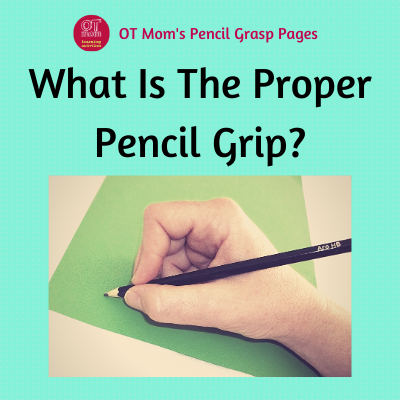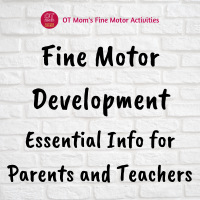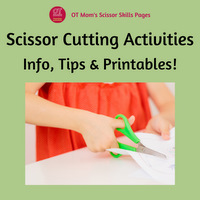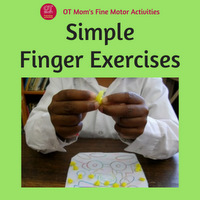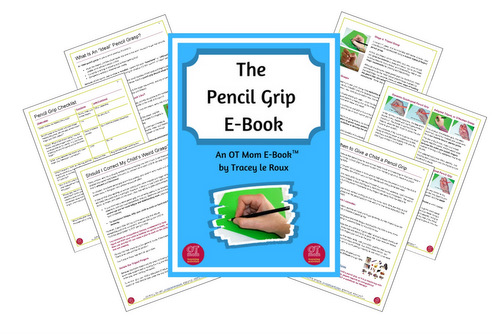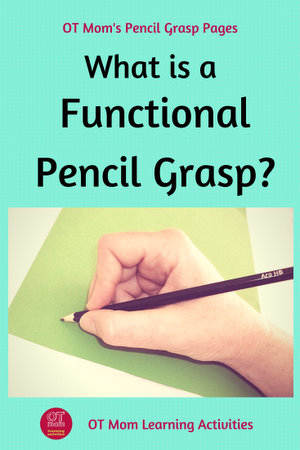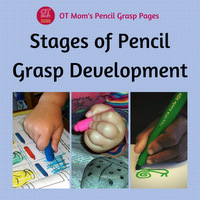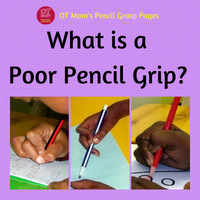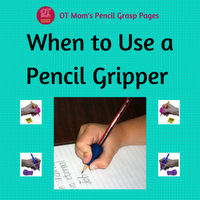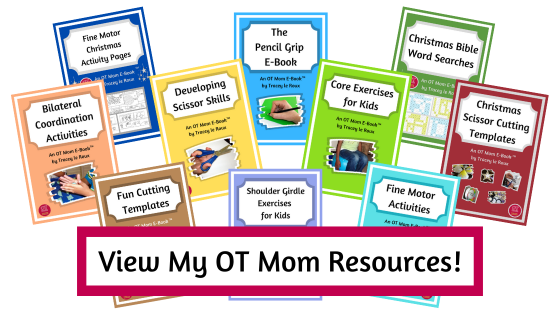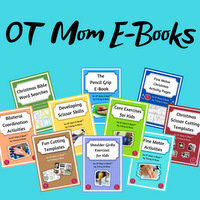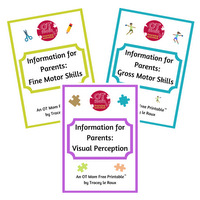- Home Page
- All About Pencil Grasp
- Best Pencil Grasps for Handwriting
Correct Pencil Grasp
Is there such a thing as a correct pencil grasp? Is there a best way to hold a pencil?
The “dynamic tripod” grasp, where the thumb, index and middle fingers are holding the pencil, has long been considered to be the proper way for a child to hold a pencil. However, there are some variations that can also be effective and efficient.
Although most of the pictures on this page are of right-handed children, the information is equally valid for left-handed kids as well!
I sometimes link to products (#Ad) that are similar to those I use and love. If you do purchase something through my links, I will receive a small commission that helps support my site - thank you!
Is There A Correct Pencil Grasp?
The best way to hold a pencil is a grasp where the child is able to:
- Move the fingers (not the whole hand, the wrist or the arm), because the fingers are more efficient at controlling the pencil
- Complete a writing or drawing task without getting tired
- Complete a writing or drawing task neatly
Because all the factors above relate to function, I prefer the term “functional” or “efficient” to describe the pencil grasp, rather than focusing on whether it is the correct pencil grasp or not.
Studies have shown that being able to use the small muscles of the hand and fingers plays a big role in a child’s handwriting, so it makes sense that the best way to hold a pencil should allow for those refined finger movements.
An immature or poor pencil grip tends to block the finger movements, which results in the child moving from the wrist or from the arm in order to write.
So, with that in mind... what does an efficient, effective, functional pencil grasp look like? Read on to find out!
Stability and Mobility
When writing, we want the fingers to be able to move freely, comfortably and without getting tired. And the best mobility comes from having a stable base to work from.
When holding a pencil to write, the fingers holding the pencil are moving, so that is the mobile part of the hand. The stability comes from the fingers that are NOT involved in holding the pencil.
The natural design of the hand creates an ideal mobility/stability split between the thumb+index+middle fingers on for mobility, and the ring+little fingers for stability (also known as ulnar stability as it occurs on the ulnar side of the hand).
When the ring and little fingers are tucked out of the way on the side of the hand, this forms an arch of the knuckles running from the index to the little fingers (the distal transverse metacarpal arch).
The DTM arch is important as it gives stability to the joints and muscles of the hands while the tripod fingers are moving and thus reduces fatigue during handwriting.
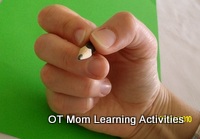 The ring and little fingers are curled into the palm, forming the DTM arch
The ring and little fingers are curled into the palm, forming the DTM archTherefore, the ideal pencil grasps have a good balance between stability and mobility - in other words, the child is able to freely move the fingers holding the pencil, while having enough stability from the uninvolved fingers.
What Are Different Ways To Hold A Pencil?
Pencil grips can be classified in different ways, usually according to the number of fingers holding the pencil, and the position of the thumb on the shaft of the pencil.
The traditional recommendation is the best way to hold the pencil is the “dynamic tripod” grasp, where the thumb, index and middle fingers are holding the pencil as shown.
However, there are some variations on the dynamic tripod grip that researchers have found to be almost equally efficient during limited clinical trials. I demonstrate and explain these below.
Remember, these can be used by right- and left-handed kids!
Dynamic Tripod Pencil Grip
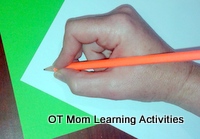 Dynamic Tripod Pencil Grip
Dynamic Tripod Pencil Grip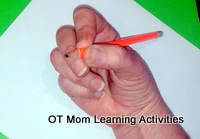 Side View
Side ViewThe tips of the thumb, index and middle fingers control the pencil in the dynamic tripod pencil grip. The thumb is opposed to the fingers, while the ring and little fingers are curled into the hand to give stability.
The dynamic tripod pencil grip grip enables the fingers to move freely, thus forming letters smoothly. This is why many teachers consider it to be the correct pencil grasp.
When a young child has three fingers on a pencil as shown, but is still using wrist or arm movements to form letters, then it is called a static tripod grip, and is considered immature.
Adapted Tripod, or D'Nealian Pencil Grasp
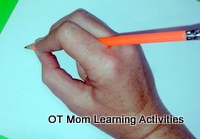 D'Nealian Pencil Grip
D'Nealian Pencil Grip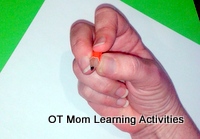 Side View
Side ViewThis unusual, but effective grip, has been especially useful for children and adults who have low muscle tone or painful joints.
The tips of the thumb, index and middle fingers hold the pencil, but the pencil rests between the index and middle fingers, instead of in the webspace next to the thumb.
This adapted tripod grip offers stability, and does not require as much pressure from the thumb to hold the pencil in place.
Read more about how this interesting grip can help children and adults who have low muscle tone or painful hands!
Dynamic Quadrupod Pencil Grip
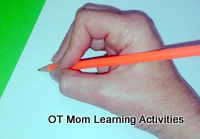 Dynamic Quadrupod Pencil Grip
Dynamic Quadrupod Pencil Grip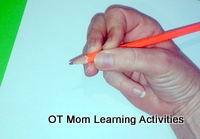 Side View
Side ViewIn the dynamic quadrupod grip, the tips of the thumb, index, middle and ring fingers control the pencil. The thumb is opposed to the fingers, while the little finger is curled into the hand to give stability.
The presence of the fourth finger on the shaft tends to limit the range of movement a little, and there is a little less stability with only the little finger curled in on the side.
Lateral Tripod Pencil Grip
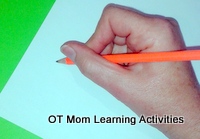 Lateral Tripod Pencil Grip
Lateral Tripod Pencil Grip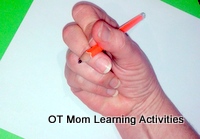 Side View
Side ViewThe lateral tripod uses the thumb, index and middle fingers to grip the pencil shaft. Although the tips of the index and middle fingers are used, it is the pad of the thumb that is used in this grip.
In a lateral grasp (whether tripod or quadripod), the thumb crosses over the shaft of the pencil, and the pad of the thumb often rests against the index finger (instead of the pencil shaft). This often blocks the full range of finger movements when compared to a dynamic tripod grasp.
The webspace (between the thumb and index finger) is a bit smaller with a lateral grasp, which limits some of the movement, and requires a bit more effort from the thumb to hold the pencil steady.
Lateral Quadrupod Pencil Grip
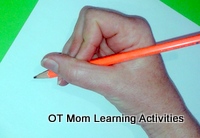 Lateral Quadrupod Pencil Grip
Lateral Quadrupod Pencil Grip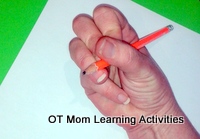 Side View
Side ViewThe lateral quadrupod is very similar to the lateral tripod, except that the ring finger is also involved in holding the pencil and the stable arch is reduced.
Again, the pad of the thumb is used instead of the tip of the thumb.
Children using this grip may tire more easily during a long writing task than those using a more dynamic grip. This is possibly owing to the reduced stability on the side of the hand and/or the use of additional fingers to form the letters.
Help Your Child Develop A Good Pencil Grip
Your child will probably NOT develop a better pencil grip just by having more practice with a pencil or crayon.
It is far better to look at some of the underlying skills needed for pencil control and to help your child develop these skills properly.
Read my article on the Essential Bases for Fine Motor Skills, and please do consult an occupational therapist for an assessment if you are at all worried about your child's development.
1) Lots Of Cutting With Scissors
When your child uses scissors correctly, the thumb, index and middle fingers get lots of practice in working together. These are the fingers used to control a pencil.
Using the correct scissor grasp, with the ring and little fingers tucked into the hand, will help develop stability on the ulnar side of the hand, which helps with the hand stability needed for handwriting.
Check out these scissor cutting pages on my site:
2) Strengthen Core and Shoulder Girdle Muscles
Strengthening your child's core and shoulder girdle muscles will help your child's hand and finger muscles to move more freely. (Think how much more easily you can paint a wall when you are standing on a steady ladder rather than a wobbly one!)
Check out these gross motor pages on my site:
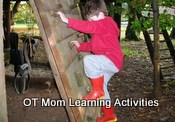
3) Work On Hand And Finger Skills
Recent research has shown that having a so-called correct pencil grasp is not as important as whether the fingers can move freely to form the letters in handwriting.
Give your child a head start on finger movements by incorporating some of these really easy activities into your daily routine:
Do you want all my pencil grip information in an accessible download? Then check this out:
Get All My Pencil Grip Info and More!
This printable resource aims to help by answering common questions that teachers and parents have about how a child should hold a pencil.
This e-book explores various functional pencil grasps, dysfunctional pencil grips, and the various developmental stages of holding a pencil.
Lots of photos, as well as a pencil grasp checklist!
Thanks for visiting! Please sign up for my occasional free newsletter to stay in touch with new pages and activities on my site!
- Home Page
- All About Pencil Grasp
- Best Pencil Grasps for Handwriting
Share this page to help others!
Related Pencil Grip Pages
References
1. Koziatek, S. ; Powell, N.J. Pencil Grips, Legibility, and Speed of Fourth-Graders' Writing in Cursive AJOT 57(3):284-8 May 2003
DOI: 10.5014/ajot.57.3.284
2. Schwellnus, H.; Carnahan, H. ; Kushki, A. ; Chau, T. Writing Forces Associated With Four Pencil Grasp Patterns in Grade 4 Children AJOT March 2013
DOI: 10.5014/ajot.2013.005538
3. Selin, A-S. Pencil Grip: A Descriptive Model And 4 Empirical Studies (dissertation). Abo Akademi University Press, 2003.
ISBN 951-765-130-9
4. Ziviani, J. ; Elkins, J. Effect of Pencil Grip on Handwriting Speed and Legibility. Educational Review 38(3):247-257 • November 1986
DOI: 10.1080/0013191860380305
Didn't find what you were looking for? Try a search of my site!
